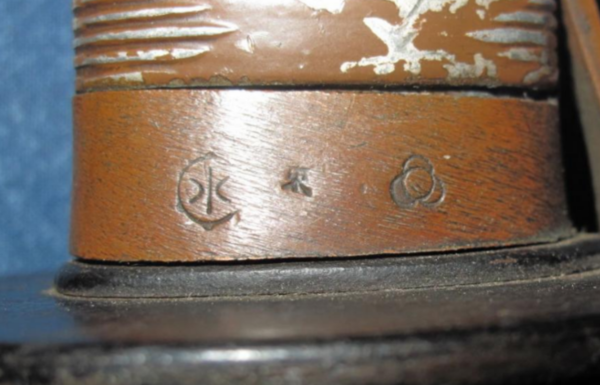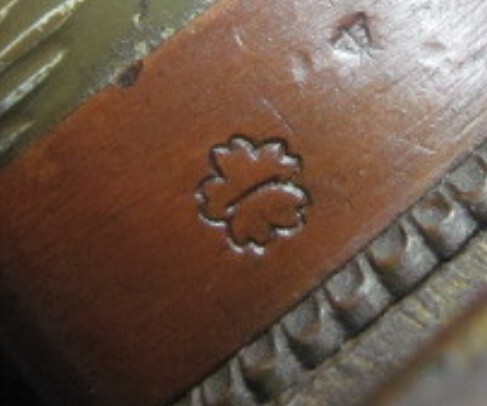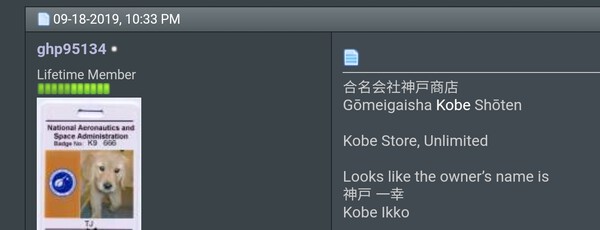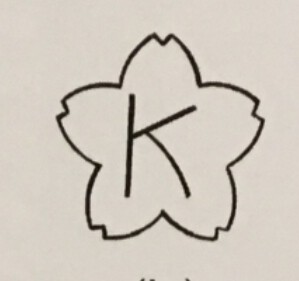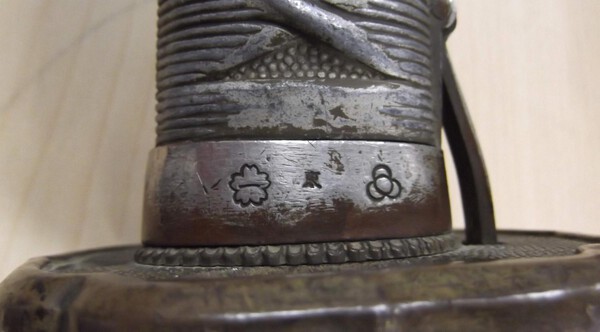-
Posts
13,004 -
Joined
-
Last visited
-
Days Won
155
Content Type
Profiles
Forums
Events
Store
Downloads
Gallery
Everything posted by Bruce Pennington
-
It’s rayskin like me the army. Navy simply laquered It black.
-
Well shoot. With my bad eyes and those original pics, I mistook the "0" for a shop stamp. Sorry, but much better pics, BTW! I can see what you mean about the original black tsuba being overcoated with the copper finish. Odd.
-
It’s nothing special Austus. I just collect stamps and am curious about the one on your fittings.
-

What's the most you spent on a sword?
Bruce Pennington replied to piryohae3's topic in General Nihonto Related Discussion
The most I've spent is $2,400 (twice). One for a copper-handled Type 95 and another for a Kaigunto with a koto blade and rayskin saya. But I've got a pretty small hobby fund. -
Austus, Could I get a good clear pic of that stamp inside the fuchi and backside of the seppa?
-
Ernie & Steve, Thanks for verifying all this! Ah, the round Seki! I had forgotten about that one! I've seen partials on fuchi, but never a good, complete one. If one of you guys have a good example, I'll add it to the Stamps Document. There are examples of it on the foil Seki acceptance stickers on saya, but I don't have a good one on fuchi. Ok, so there's now 2 guys I trust who are saying the evolution from "K" to "一" (Kobe Shoten) has merit. Well, I'm going to move the Ichi stamp out of "Unknowns" then, and put it down as a "Possibly later Kobe".
-
You might as well add: ホ (Miso) Thomas, I don't doubt what you are saying, as you are uncovering an amazing amount of previously unknown info, critical info, to our collecting world; BUT it would be helpful to us all if you could expound, or provide some of the evidence of Kokura's 1st arsenal producing blades. We have been hearing from some pretty knowledgable people, for years, that Kokura was administrative oversight and didn't produce gunto. It would help to see some of the evidence you are reading (with English edits, like Nick Komiya does). As a counter idea, though, I have always taken examples like you provided above, to mean that someone else made a blade, like Nagoya, and it's final inspection came by Kokura inspectors. For the first several years, Nagoya and Seki production was under Kokura supervision. It was somewhere around 1942ish that Kokura's role was decommissioned and Nagoya and Tokyo 1st took over.
-
Ok, while what you propose is possible, we really don't have any proof. The arsenals were given blocks of numbers to use on their blades. The blades themselves were made by a few contractors. We can speculate that K and 一 were from the company, however they could have been from two different companies. We just don't know. But it's an idea to watch. SEKI - You lost me. When or where was "刀" used to mark Seki-made blades?
-

Need Help With WW II Katana Blade ID
Bruce Pennington replied to keno's topic in Military Swords of Japan
Ken, Appears to be a standard Type 98 Japanese officer sword. You can read more than you ever can know at Ohmura's site: http://ohmura-study.net/900.html Hard to tell if traditionally made or not due to condition of the blade, but my guess is non-traditional. Doesn't mean "machine made", that's a misnomer. Mostly it means oil-quenched rather than water, but he nihonto guys can give you a more expert opinion on that. The wood/leather cover is often called a combat saya. The all-brown tassel is now believed to be used by the ciivian forces that worked with the army, called Gunzoku (read about it here:http://www.warrelics.eu/forum/Japanese-militaria/what-were-regulations-army-civilian-employees-carry-swords-701783/). Both the NCO and officer equivelants were authorized to wear Type 98 officer gunto. -
Is that what the kanji means? That has a very suspicious resemblance to “Misuno”!!! Maybe we just figured out which stamp came from the Misuno company! Thanks Trystan!
-
-
After re-reading all this, I can see I've misunderstood. We are not talking about the "Ichi" stamp, you (Thomas) simply introduced a new topic about the manufacturer named "合名会社神戸商店". I re-read the post where George Trotter posted that ad from them and cannot find which gunto in the previous thread he was refering too. The name was translated by Guy, at Warrelics, as "Kobe Shoten". I confused the issue by thinking we were talking about the "Ichi" stamp. Kobe, as postulated by Ohmura, used the "K" stamp.
-
But since it's in Japanese, there are very few of us who can profit from it. We could all use a name to call this contractor. I'll run this name and ad by Nick Komiya and see if he can break the code for us. Thomas, How is it that you've linked this name to the "Ichi" stamp? Was it through George Trotter's suggestion, or another source?
-
-

A look at the Japanese Imperial Household Dirk
Bruce Pennington replied to matthewbrice's topic in Military Swords of Japan
Very cool, Matt! Was it a "chance" find, or something you were searching for? -
Thomas, that's fantastic! Before you joined us, Nick Komiya, over on Warrelics.com, was our only researcher that could dig into the old war records and give us insight from them.
-
Rich, Yes, quite a help! It is part of the Stamps document, thank you!
-
Thank you Thomas! I've added them to the Stamps Document. Can you help me understand the document you've posted? Is it something from WWII records? What is it saying?
-

Attention Mantetsu Owners: A Survey
Bruce Pennington replied to Bruce Pennington's topic in Military Swords of Japan
Yes, I see, however before this current discussion I had no idea what that meant. -
Well, after a second look, it does look original. I’m just not used to seeing Kaigunto with anything but black.
-
The fittings are normal, but someone has over-cleaned them removing the black paint from the seppa and tsuba. The “gold plating” is a figure of speech that we all use. It’s not really gold, and is how all the navy fittings are supposed to look.
-
David, That would have to be my guess too. It's incomplete, but it doesn't resemble any of the known manufacturer stamps, so I'd lean to Seki. Definitely an unusual place for it, but I have seen stamps on fittings before.
-
Austus, The stamped number, matching the numbers on the fittings, are put there by the shop that fit the blade out originally. That there are no other stamps present is not unusual. It's not a guarantee that the blade is traditionally made though, as the stamping didn't really get serious until 1940. So it could have been made before that. Also, blades made for the navy didn't seem to get stamped as religiously as the army blades did. Other guys more expert in spotting nihonto will have to chime in about it, but my bet is that it's not traditionally made. The saya was probably grabbed by a G.I. and put with the blade. It was common for a guy to pick up a blade without a scabbard and look around before returning home to find a scabbard for it. Can't say about the edge sharpness. From your pics, it looks like it might have been polished, post-war. Maybe the polisher didn't finish off the edge? There was an official requirement to dull the edge of blades "in peacetime", but as far as I know, there were only a couple of years in the '30s that qualified for that requirement.
-
I'm with Stephen on this. I have my swords because someone offered them for sale on ebay, auction houses, and dealer sites. Each one challenged me to learn more as I went. My grown daughter may keep them, but she may sell them off for much needed cash. The buyers will likely be beginners who are looking for their first good Type 95/97/98, and excited when they receive it in the mail.
-

Attention Mantetsu Owners: A Survey
Bruce Pennington replied to Bruce Pennington's topic in Military Swords of Japan
OK!!! Just finished charting out the numbers by the iroha system, and VIOLA! - they are in a logical order by year!!! I only posted the first number of each group to save space, though in '42 I posted 3 "Ya" numbers because it is the only kanji I have that goes through all 3 seasons (for some reason, I have no record of any numbers marked "summer"). If I could find Moritasan and Thomas I'd hug you both! NEW CHART.pdf




